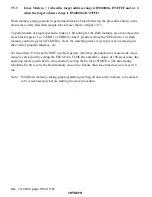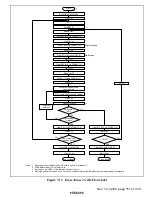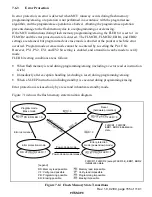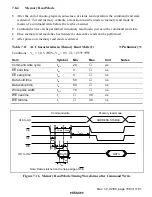
Rev. 1.0, 02/00, page 158 of 1141
7.8.3
Writer Mode Operation
Table 7.9 shows how the different operating modes are set when using writer mode, and table 7.10
lists the commands used in writer mode. Details of each mode are given below.
•
Memory Read Mode: Memory read mode supports byte reads.
•
Auto-Program Mode: Auto-program mode supports programming of 128 bytes at a time.
Status polling is used to confirm the end of auto-programming.
•
Auto-Erase Mode: Auto-erase mode supports automatic erasing of the entire flash memory.
Status polling is used to confirm the end of auto-erasing.
•
Status Read Mode: Status polling is used for auto-programming and auto-erasing, and normal
termination can be confirmed by reading the IO6 signal. In status read mode, error
information is output if an error occurs.
Table 7.9
Settings for Each Operating Mode in Writer Mode
Pin Names
Mode
FWE
&(
&(
&(
&(
2(
2(
2(
2(
:(
:(
:(
:(
IO0 to IO7
A0 to A17
Read
H or L
L
L
H
Data output
Ain
Output disable
H or L
L
H
H
Hi-z
X
Command write
H or L
*
3
L
H
L
Data input
Ain
*
2
Chip disable
*
1
H or L
H
X
X
Hi-z
X
Notes: 1. Chip disable is not a standby state; internally, it is an operation state.
2. Ain indicates that there is also address input in auto-program mode.
3. For command writes when making a transition to auto-program or auto-erase mode,
input a high level to the FWE pin.
Table 7.10
Writer Mode Commands
1st Cycle
2nd Cycle
Command Name
Number of
Cycles
Mode
Address
Data
Mode
Address
Data
Memory read mode
1 + n
write
X
H'00
Read
RA
Dout
Auto-program mode
129
write
X
H'40
write
WA
Din
Auto-erase mode
2
write
X
H'20
write
X
H'20
Status read mode
2
write
X
H'71
write
X
H'71
Notes: 1. In auto-program mode. 129 cycles are required for command writing by a simultaneous
128-byte write.
2. In memory read mode, the number of cycles depends on the number of address write
cycles (n).
















































